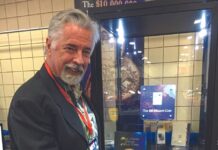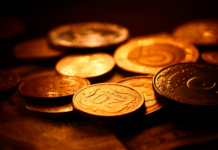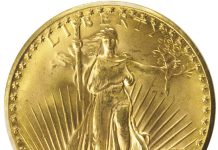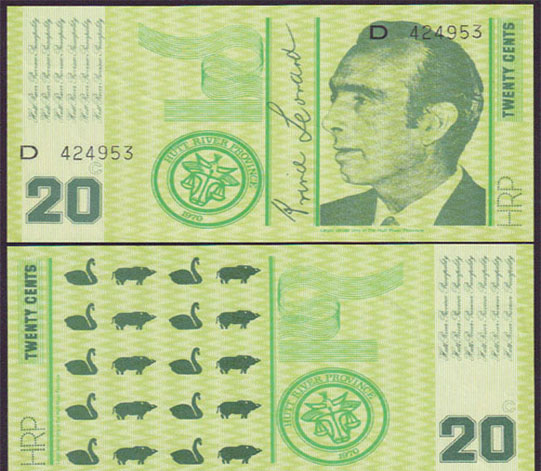
By Dr. Kerry Rodgers
Few countries are as misunderstood as the Principality of Hutt River.
Collectors will be hard-pressed to find its issues in the Standard Catalog of World Coins. Some other catalogs go so far as to dismiss its coins and notes as fantasies, placing them alongside those contrived for Easter Island—or even Atlantis.
Yet the principality, some 370 miles north of Perth, is a self-proclaimed independent, sovereign entity, enclosed within the State of Western Australia. The independence and legal status of Hutt River, which occupies some 18,500 acres, making it larger than Hong Kong or Pitcairn Island, are tacitly recognized by the Australian government.
Independent Ways
The easiest way to comprehend the status of the principality is to regard its founding as a one-man Boston Tea Party.
It dates back to 1969, when a serious political fight erupted between the wheat growers of Western Australia and the state’s government. At the heart of the matter lay the government’s intent to impose a draconian reduction in wheat quotas. This would see many farmers bankrupted and forced from their lands.
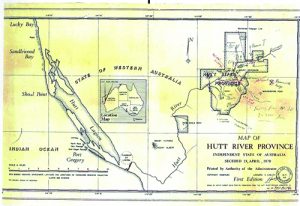
One of those affected was Leonard George Casley, whose farm occupied 18,500 acres in the valley of the Hutt River. Not only was the economic viability of his farm about to be destroyed, but he was also threatened with confiscation of his land.
When Casley failed to get satisfaction from either state or federal authorities, he invoked international law to form a “Self Preservation Government”. He seceded the family territory of Hutt River from Western Australia and the Commonwealth of Australia. As Casley read the situation, his plight and that of his family were no longer a matter for Australian law.
Casley proclaimed the independence of the Hutt River Province (HRP) on April 21, 1970. He was elected administrator of the new state. Following close examination of relevant law, he assumed the title of His Royal Highness Prince Leonard I. The Hutt River Province then had a population of 12.
On Sept. 12, 2006, the word “Province” was formally dropped from the state’s title and it became the Principality of Hutt River (PHR).
Independent State
Since the principality’s founding, the Australian government has been somewhat ambivalent over its legal position. The Commonwealth of Australia has never formally recognized PHR, but has never tested its independence directly in court. At least two internal federal government memos accept PHR’s legal status, while a Commonwealth of Australia court has declared PHR postage stamps “legitimated and validated”.
In the principality’s early days, various state and federal agencies went out of their way to make life as difficult as possible for the prince and his family. The Australian Tax Office made a number of attempts to take action against Prince Leonard and other PHR citizens. These actions either failed or were withdrawn before getting to court. Indeed, in 2008, Prince Leonard and his wife, Princess Shirley, received letters from the Australian Taxation Office declaring them to be “non-resident of Australia for income tax purposes”.
The Australian Federal Government would appear anxious to avoid any open legal challenge to PHR, despite the principality’s engagement in activities that would normally bring down the wrath of authorities. These include issuing visas and passports and, perhaps most importantly, stamps and coins.
Today, conflicts with the Australian authorities, including a declaration of war, are a distant memory and Prince Leonard is the subject of a permanent exhibit at the National Museum of Australia in Canberra. The 40th anniversary of independence was successfully celebrated in 2010. More than 2,000 attended, including many dignitaries, including the Prime Minister of Australia and the Governor and Premier of Western Australia.
Today, Western Australian State Government tourist maps promote PHR. And a major tourism magazine rates PHR’s settlement of Nain as one of Australia’s 100 must-see places.
The principality’s claim to independence appears to be acknowledged throughout Australia—without any official or politician in that country openly admitting anything.
Coining It
The currency unit is the PHR dollar, which is tied at a ratio of one-to-one to the Australian dollar.
The first coins were issued in 1976. They consist of four denominations: 5, 10, 20 and 50 cents. These base-metal issues all have a common design showing a profile of Prince Leonard on the obverse and the coat of arms of HRP on the reverse. The coins were struck at Canada’s Lombardo Mint with a mintage of 2,000 of each denomination. Further issues were produced in 1977 (1,000 coins each) and 1978 (500 coins each). Proof issues exist for all three years.
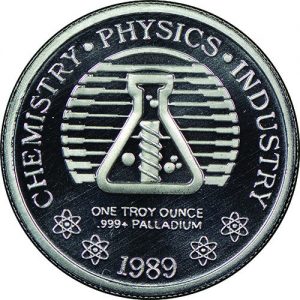
A .999-fine silver, 38.1 mm $30 proof with a reeded edge and a .999-fine gold, 25 mm $100 proof with a plain edge were produced in 1976.
Mintages were 2,000 and 500, respectively. Oddly, two different die pairs are known for the gold coin.
The first commemorative coin appeared in 1977. It was a pierced cupronickel 33 mm $1 struck to mark the Silver Jubilee of Queen Elizabeth II. The obverse showed the HRP coat of arms with the inscription “QUEEN’S JUBILEE” on the reverse. Mintage was 1,000. In 1978, a similar design, but without the inscription, was produced as a circulation strike. Mintage was 500.
Silver $30 and gold $100 coins also were issued in 1977 showing a red-capped robin on the reverse of the $30 and a wedge-tailed eagle on the $100. Mintages were 1,000 and 500, respectively. A small number of trial strikes—possibly 10 examples—of the $100 exist in cupronickel. In 1978, $30 and $100 coins saluted Capt. James Cook’s ship HMB Endeavour. Again mintages were 1,000 and 500, respectively.
Throughout this initial period, Christine Norman designed all the coins, which were struck in toto by the Lombardo Mint.
In 1979, $30 and $100 issues celebrated Skylab, and in 1980 the Queen Mother got the nod with a $100 coin. Again Lombardo Mint produced the coins, but the designer is unknown, as are the (low) mintages. No further coins were issued until 1984.
Scamming It
From 1984 on, an extraordinary raft of coins was issued under the stewardship of Kevin Gale.
Gale had inveigled himself into Prince Leonard’s trust in the 1970s. He was based in Queensland, on the other side of Australia from HRP. From there, he undertook to manage several of HRP’s commercial operations, including the marketing of its coins and stamps. At no time did Gale have power to authorize any coins. All issues, including their designs, had to be approved by HRP.
For a number of years, all seemed fine. A quality mint produced the coins. Sales were good. Interest in HRP was promoted. Gale was knighted by the prince for his efforts.
But then Prince Leonard became aware that all was not what it seemed in sunny Queensland. He made inquiries. These pointed to the wholesale issue of unauthorized stamps and coins, with many of the latter being struck by an unknown Queensland mint.
In 1995, the Prince demanded a full accounting of the Queensland operation. He was set to arrive in person when Gale died suddenly. It was now found that Gale had in fact registered “Hutt River Province” as the name of a Queensland company of which he was sole owner and from which no profits accrued to HRP. The records of this operation could not be located, but it was clear that vast numbers of coins had been produced for the U.S. market.
Few if any coins from this period show the effigy of Prince Leonard.
The associated issues can be divided into two groups. The first were struck by Johnson Matthey.
Curious Minting Processes
These include commemoratives for George Orwell (1984), the second inauguration of President Ronald Reagan (1985), the centenary of the automobile (1985), the centennial of the Statue of Liberty (1986), the America’s Cup (1987), the Olympics (1988), and the U.S. Oath of Office Bicentennial (1989). Denominations, sizes, and coin composition vary, but most were struck in .999-fine silver or .999-fine gold.

In 1989, Gale shifted operations to the New Queensland Mint, a subsidiary of the Continental Coin Co. of California.
The first coin from this period was a .999-fine, one-ounce $100 palladium issue reflecting CHEMISTRY · PHYSICS · INDUSTRY. In 1990, a one-ounce silver $5 appeared with the legend ONE SILVER KOALA/AUSTRALIA’S TEDDY BEAR. And in 1991, a single 22-carat-gold-plated cupronickel $20 marked the 50th anniversary of the Japanese attack on Pearl Harbor. The designer was Frank Gasparro, former chief sculptor-engraver of the U.S. Mint.
Its mintage was an all-time high of 10,000 coins. This was a foretaste of what was to come, as issues and mintages went through the roof.
First up was a whole series for Operation Desert Storm, dated 1991. At least 107 different coins were produced in three denominations, in three different compositions, and two different qualities, with three different obverses.
These were followed by 46 designs marking the 50th anniversary of World War II. The first, in 1992, consisted of numerous 39 mm BU cupronickel $5’s. A second 1991-1995 set of 44 mm BU $10’s with identical designs was struck using World War II cartridge brass.
Then, in 1992 and 1993, came two series of “Fathers of Baseball”, again produced in a confusing series of compositions and denominations. These were followed by coins for the inauguration of President Bill Clinton (1993), a proposed giant dinosaur series (only one coin in 1993), 12 $10’s struck in cartridge brass to mark the 80th anniversary of the outbreak of World War I (1994), and four different 1994 coins for the “Los Angeles International Soccer Competition”, a renaming of the 1994 FIFA World Cup to circumvent the copyright FIFA exercises over its name and logo.
With Gale’s death, the spate of unauthorized U.S.-themed HRP coins stopped abruptly. Prince Leonard declared Gale a traitor and posthumously stripped him of all titles and honors.
Few, if any, of the coins struck by the New Queensland Mint were authorized by HRP. The Johnson Matthey strikings are equally murky. In the absence of records, officials of the principality have found it easier for them—and collectors—to accept all as official issues.
The Straight and Narrow
At this point, HRP coin production took a hiatus. When it recommenced in 2000, Prince Leonard had the reins firmly in his hands. His focus was directly on the principality.
The 2000 coin was a $100 commemorative to celebrate the 30th anniversary of secession. Mintage of the 24 mm, 8-gram .999-fine gold coin was limited to 25. The obverse shows the principality’s state crown; the reverse design, by Allan Sterling, depicts HRP’s biblical gateway. The coin was struck at the Wyndham Mint. Two trial strikes are known in .999-fine silver.
The next issue, in 2007, celebrated the 60th wedding anniversary of Prince Leonard and Princess Shirley. It also served to mark the 37th anniversary of independence. The 50 mm $30 coin was struck in .999-fine gold-plated brass and weighed in at 78.5 grams. Mintage was 1,000. This was the first coin to show the state’s name as PRINCIPALITY OF HUTT RIVER.
A contemporary 2007 set depicted the armorial bearings of Prince Leonard and his four sons: Crown Prince Ian, Grand Duke of Hutt; Prince Wayne, Duke of Nain; Prince Richard, Duke of Carmel; and Prince Graeme, Duke of Gilboa. Prince Leonard and his arms figured on a 35 mm, 15.4-gram nickel-plated zinc alloy $10 coin. His sons and their arms were depicted on 30 mm, 11-gram $5’s of the same composition.
Lest We Forget
Also in 2007, Prince Leonard authorized a special “Lest We Forget” issue to express his concern about the legal standing of Australians born in the country prior to Jan. 26, 1949. The prince has long been concerned by what he considers to be the problematic legal status of 8 million folk persons born in Australia before that date.
Anyone curious to follow the legal argument can check out the PHR website: www.principality-hutt-river.com.

In brief, in 1948 Great Britain withdrew U.K. citizenship from Australians making them “British subjects” or “Commonwealth citizens”. Australia’s federal government did not get around to passing its Citizenship Act until Jan. 26, 1949, when it granted citizenship to all British subjects and those born in Australia after that date.
However, in 1973 the Australian Citizenship Act was amended. All reference to “British subjects” was deleted. Consequently, Prince Leonard argues that unless Australians born before Jan. 26, 1949, have since become naturalized, they are stateless persons.
The $5 nickel-plated zinc alloy coin is 35 mm in diameter and weighs 16 grams. The coin’s reverse design stresses the Prince’s special concern for those servicemen and women who fought for Australia, but whom he regards as having lost their citizenship due to legal bungles.
The LWF coin was reissued in 2009.
HRH Prince Leonard
One of the more impressive coins from the principality is a $30 piece struck in 2010 to mark the 40th anniversary of independence. The reverse shows Prince Leonard’s star in the Constellation of Virgo.
Prince Leonard was born in Virgo. In August 1999, star SAO 119916—located at RA: 13h 24m 42s, D: + 4° 24’ 08”—was named “HRH Prince Leonard” in his honor. In star catalogs, it is referred to as HIP 65442, PPM 159732 or HD 116621. (Stars seem to be almost as bad as coins in having multiple catalog numbers.)
The striking design for the coin’s reverse shows Virgo, goddess of justice, agriculture, and the harvest, draped tastefully in classical Grecian style, and carrying a sheaf of wheat in her left hand and a palm frond in her right. She is overlaid by the stars of her constellation, with the position “HRH Prince Leonard” shown at her right hip—an appropriate place for a chivalrous man guarding his lady.
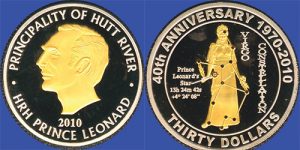
For Prince Leonard, Virgo’s wheat sheaf is a compelling symbol. It recalls the government-imposed draconian reductions in wheat quotas that threatened to destroy his farm and led him to declare independence 40 years earlier.
The dual gold- and silver-plated coin is struck on a 45 mm diameter, 3.5 mm thick, 40g brass flan. Virgo is shown in matte gold, as is the prince’s effigy on the obverse. The lettering, including that defining the location of the prince’s star, is selectively plated in matte silver. Mintage is 1,000.
Princess Shirley passed away on July 7, 2013, and on Feb. 11, 2017, citing old age and ill health, Prince Leonard abdicated his position as sovereign in favor of his youngest son, Prince Graeme.


